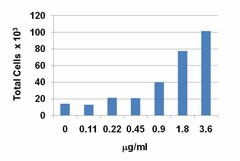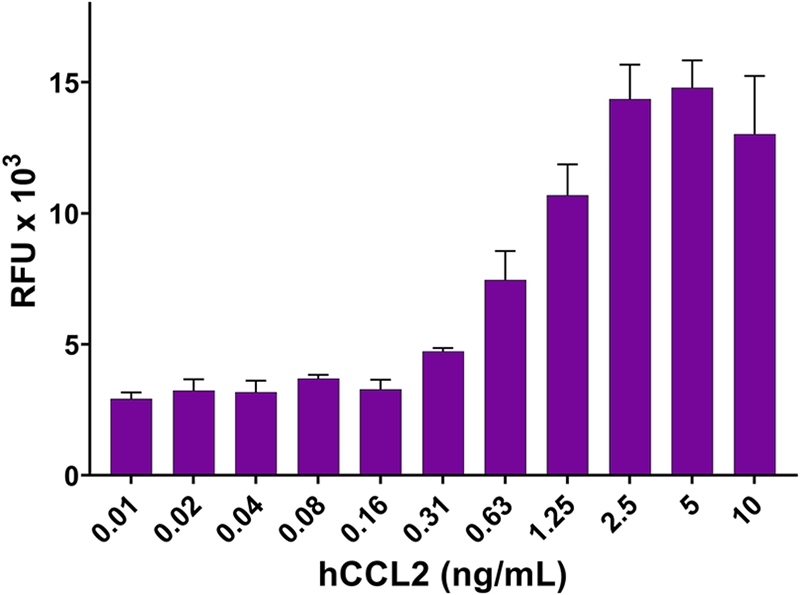- Regulatory Status
- RUO
- Other Names
- Pre-B-cell growth-stimulating factor (PBSF), stromal cell derived factor 1 isoform beta precursor (SDF-1β)
- Ave. Rating
- Submit a Review
| Cat # | Size | Price | Quantity Check Availability | Save | ||
|---|---|---|---|---|---|---|
| 587702 | 10 µg | 165€ | ||||
| 587704 | 25 µg | 240€ | ||||
| 587706 | 100 µg | 549€ | ||||
CXCL12β is constitutively expressed by stromal cells. SDF-1α (89 amino acids) and SDF-1β (93 amino acids) are derived from the CXCL12 gene by alternative splicing. They have identical amino acid sequences, differing only by the addition of four amino acids at the carboxy-terminus of the β form. CXCL12α and β are ubiquitously expressed, and it has been suggested that their activity is regulated through differential proteolytic processing. Proteases present in serum process CXCL12α initially at the carboxy-terminus (through carboxypeptidase N) and subsubsequently at the amino-terminus (through CD26); while CXCL12β is only processed at the animo-terminus. These proteolytic processes affect the chemokine's properties to bind to heparin and cells, and stimulate proliferation and chemotaxis. CXCL12α is inactivated by other enzymes such as metalloproteinases, serine proteases, and leukocyte elastase. CXCL12/CXCR4 pair plays a key role in maintaining proliferation and survival of bone marrow stem cell subpopulations under stress conditions. Also, CXCL12 is highly expressed in bone marrow stromal stem cells and regulates growth and survival. CXCL12 promotes survival by inducing anti-apoptotic proteins and decreasing apoptotic proteins, and increasing transcription of cell survival genes. Data suggests that CXCL12β mediates cells' survival by enhancing autophagy in bone marrow mesenchymal stem cells.
Product DetailsProduct Details
- Source
- Human CXCL12, amino acids (Ser19-Met93) (Accession# NM_000609) was expressed in E. coli.
- Molecular Mass
- The 74 amino acid recombinant protein has a predicted molecular mass of approximately 8.8 kD. The DTT-reduced and non-reduced protein migrate at approximately 13 and 15 kD by SDS-PAGE respectively. The N-terminal amino acid is Ser.
- Purity
- >95%, as determined by Coomassie stained SDS-PAGE.
- Formulation
- 0.22 µm filtered protein solution is in PBS.
- Endotoxin Level
- Less than 0.01 ng per µg cytokine as determined by the LAL method.
- Concentration
- 10 and 25 µg sizes are bottled at 200 µg/mL. 100 µg size and larger sizes are lot-specific and bottled at the concentration indicated on the vial. To obtain lot-specific concentration and expiration, please enter the lot number in our Certificate of Analysis online tool.
- Storage & Handling
- Unopened vial can be stored between 2°C and 8°C for up to 2 weeks, at -20°C for up to six months, or at -70°C or colder until the expiration date. For maximum results, quick spin vial prior to opening. The protein can be aliquoted and stored at -20°C or colder. Stock solutions can also be prepared at 50 - 100 µg/mL in appropriate sterile buffer, carrier protein such as 0.2 - 1% BSA or HSA can be added when preparing the stock solution. Aliquots can be stored between 2°C and 8°C for up to one week and stored at -20°C or colder for up to 3 months. Avoid repeated freeze/thaw cycles.
- Activity
- Bioactivity was measured by its property to chemoattract human T cells in a dose dependent manner.
- Application
-
Bioassay
- Application Notes
-
BioLegend carrier-free recombinant proteins provided in liquid format are shipped on blue-ice. Our comparison testing data indicates that when handled and stored as recommended, the liquid format has equal or better stability and shelf-life compared to commercially available lyophilized proteins after reconstitution. Our liquid proteins are verified in-house to maintain activity after shipping on blue ice and are backed by our 100% satisfaction guarantee. If you have any concerns, contact us at tech@biolegend.com.
- Additional Product Notes
-
View more applications data for this product in our Scientific Poster Library.
Antigen Details
- Structure
- Chemokine
- Distribution
-
Expressed by bone marrow stromal cells, endothelial cells, epithelial cells, pericytes, dendritic cells, fibroblasts
- Function
- CXCL12 is a constitutive chemokine involved in lung, brain, joint, and intestine inflammation. CXCL12 is chemotactic for T, B, and cancer cells. CXCL12/CXCR4 pair plays a role in mobilization of CD34+ progenitors to peripheral blood. CXCL12 is important in morphogenesis, angiogenesis, and cancer metastasis.
- Interaction
- Endothelial cells, epithelial cells, T and B cells, monocytes
- Ligand/Receptor
- CXCR4
- Biology Area
- Apoptosis/Tumor Suppressors/Cell Death, Cell Biology, Immunology, Signal Transduction, Transcription Factors
- Molecular Family
- Cytokines/Chemokines
- Antigen References
-
1. Nagasawa T, et al. 1994 Proc. Natl. Acad. Sci. USA 91:2305.
2. Muller A, et al. 2001. Nature 410:50.
3. Valenzuela-Fernandez A, et al. 2002. J. Biol. Chem. 277:15677.
4. De La Luz Sierra M, et al. 2004. Blood 103:2452.
5. Kortesidis A, et al. 2005. Blood 105: 3793.
6. Davis DA, et al. 2005. Blood 105:4561.
7. Zlotnik A, 2008. J. Pathol. 215:211.
8. Herberg S, et al. 2013 PLos One 8:e58207. - Gene ID
- 6387 View all products for this Gene ID
- UniProt
- View information about CXCL12 on UniProt.org
Related FAQs
- Why choose BioLegend recombinant proteins?
-
• Each lot of product is quality-tested for bioactivity as indicated on the data sheet.
• Greater than 95% Purity or higher, tested on every lot of product.
• 100% Satisfaction Guarantee for quality performance, stability, and consistency.
• Ready-to-use liquid format saves time and reduces challenges associated with reconstitution.
• Bulk and customization available. Contact us.
• Learn more about our Recombinant Proteins. - How does the activity of your recombinant proteins compare to competitors?
-
We quality control each and every lot of recombinant protein. Not only do we check its bioactivity, but we also compare it against other commercially available recombinant proteins. We make sure each recombinant protein’s activity is at least as good as or better than the competition’s. In order to provide you with the best possible product, we ensure that our testing process is rigorous and thorough. If you’re curious and eager to make the switch to BioLegend recombinants, contact your sales representative today!
- What is the specific activity or ED50 of my recombinant protein?
-
The specific activity range of the protein is indicated on the product datasheets. Because the exact activity values on a per unit basis can largely fluctuate depending on a number of factors, including the nature of the assay, cell density, age of cells/passage number, culture media used, and end user technique, the specific activity is best defined as a range and we guarantee the specific activity of all our lots will be within the range indicated on the datasheet. Please note this only applies to recombinants labeled for use in bioassays. ELISA standard recombinant proteins are not recommended for bioassay usage as they are not tested for these applications.
- Have your recombinants been tested for stability?
-
Our testing shows that the recombinant proteins are able to withstand room temperature for a week without losing activity. In addition the recombinant proteins were also found to withstand four cycles of freeze and thaw without losing activity.
- Does specific activity of a recombinant protein vary between lots?
-
Specific activity will vary for each lot and for the type of experiment that is done to validate it, but all passed lots will have activity within the established ED50 range for the product and we guarantee that our products will have lot-to-lot consistency. Please conduct an experiment-specific validation to find the optimal ED50 for your system.
- How do you convert activity as an ED50 in ng/ml to a specific activity in Units/mg?
-
Use formula Specific activity (Units/mg) = 10^6/ ED50 (ng/mL)

 Login / Register
Login / Register 


















Follow Us